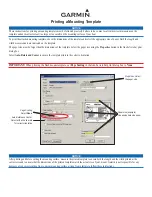
Sternfinder
1
Star Finder (Celestial Globe)
1
Indicateur d’étoiles
Bedienungsanleitung
1
Operating Instructions
1
Mode d’emploi
© 2012 FPM Holding GmbH
27
4.2 D
ETERMINATION OF THE
N
AME OF A
S
TAR
THE
A
ZIMUTH AND
A
LTITUDE OF WHICH WERE MEASURED
4.2.1 S
ETTING OF THE
S
TAR
G
LOBE WITH RESPECT TO THE
GEOGRAPHIC
L
ATITUDE OF THE OBSERVATIONAL
P
LACE
ACCORDING TO
I
TEM
4.1.1
The geographic longitude and altitude of the observational place are
approximately known and can, if needed, exactly be read off a topographic
map. Altitude and azimuth of the unknown stellar body were measured.
The altitude can be measured with a clinometer, a box compass suitable for
inclination measurements or, of course, with a theodolite; the azimuth (from
north over east) can be measured with a normal prismatic or sports compass, a
box compass or a theodolite.
4.2.2 S
ETTING OF THE LOCAL
H
OUR
A
NGLE
CALCULATED ACCORDING TO
I
TEM
4.1.5
Turn the star globe around the axis of the celestial sphere (pole holder remains
engaged) until the number of the celestial equator, indicated in degrees and
calculated as L.H.A.
3
coincides with the vertical semicircle (undivided
southern half). For setting, use the continuous numbering from 0° to 360° on
the celestial equator. Now you have an exact mirror image of the celestial
sphere on the star finder at the time and for the place of observation.
4.2.3 S
EARCHING FOR THE OBSERVED
S
TELLAR
B
ODY ON THE
S
TAR
G
LOBE
After loosening the knurled screw (13), the spring-loaded locating pin releases
the pole bore, and the vertical semicircle may be turned on the base frame
without changing the position of the star globe relative to the horizontal circle.
Set the divided side of the vertical semicircle to the observed azimuth on the
graduation of the horizontal circle and the pole holder to the observed altitude.
Read the name of the respective unknown stellar body from below the locating
pin.
















































